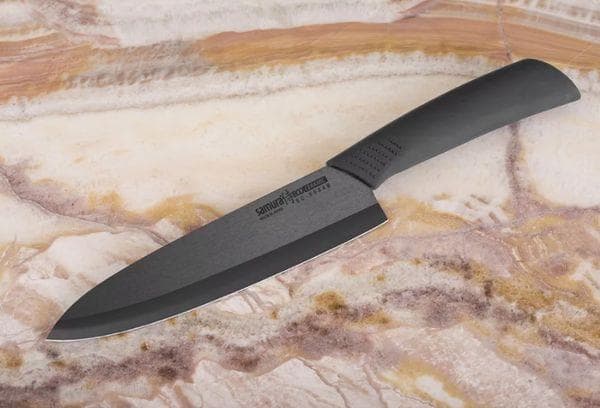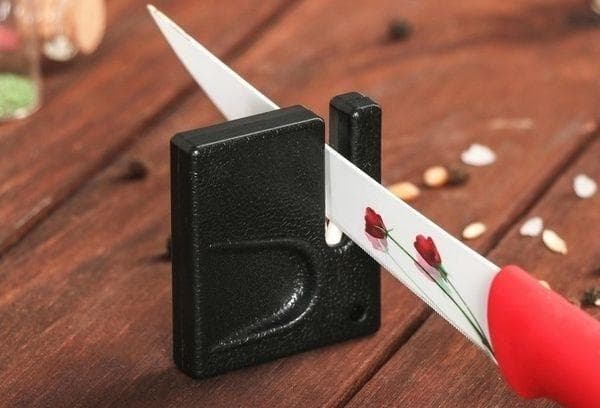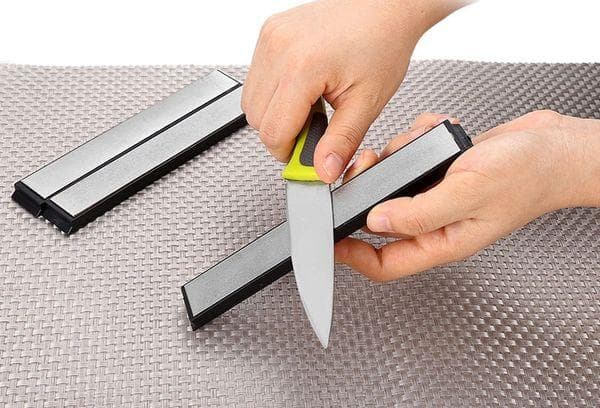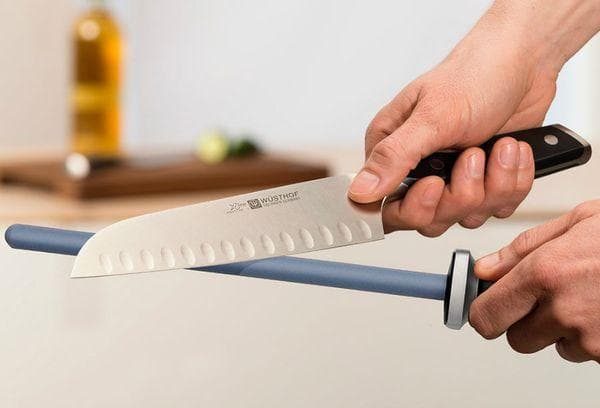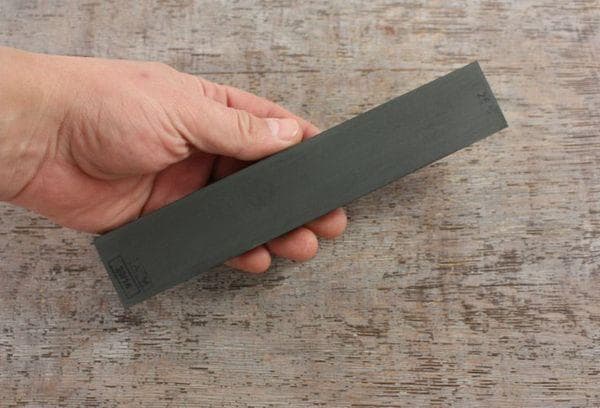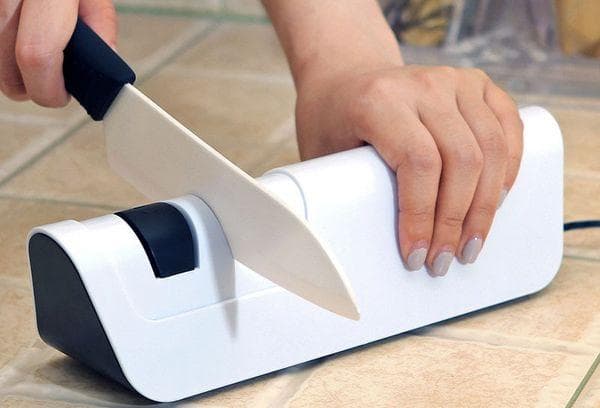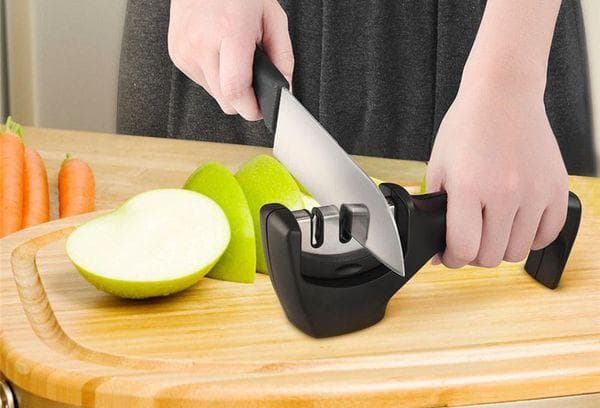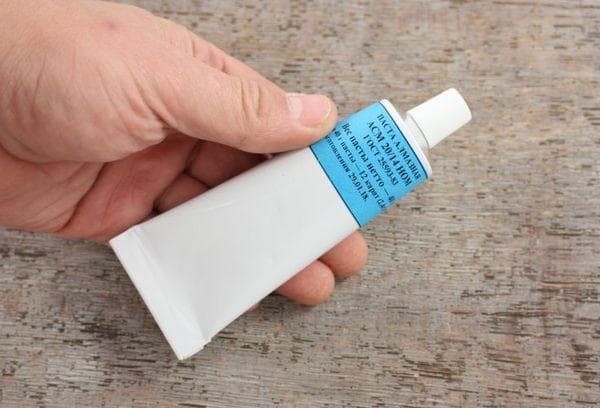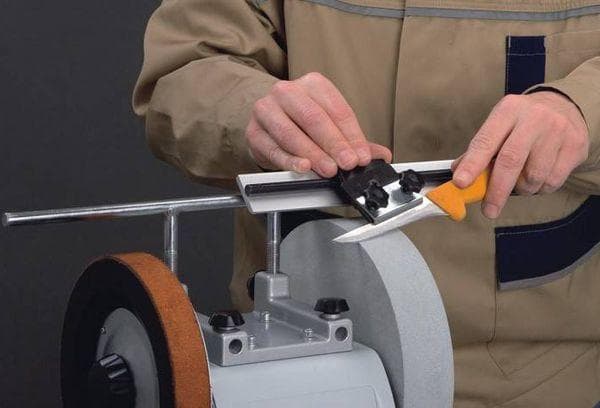How to sharpen a ceramic knife at home without damaging the blade
Content:
Working in the kitchen with ceramic knives is a real pleasure. They are lightweight, fit comfortably in the hand, and are easy to use. The blade of such knives is made of a special type of zirconium ceramic. This material has high heat resistance, but sharpening ceramic knives requires special conditions. If they are not followed, the blade can be irrevocably damaged.
What is the difference between ceramic knife blades and metal ones?
Zirconium dioxide is used to produce ceramic blades. This is a very hard material used in medical and space technologies, in high-tech enterprises. The material has nothing to do with conventional ceramics; it is called zirconium ceramics due to its production technology.
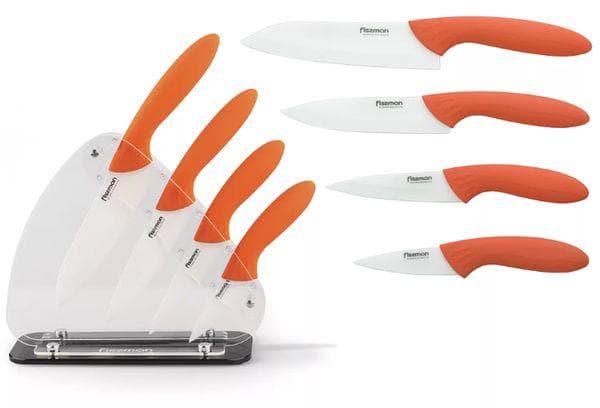
The blade is fired at high temperature in a special oven. Unlike their metal counterpart, they do not need to be sharpened every month.The ceramic knife retains its sharpness for up to one year of daily use.
The blade can be white or black. The black color of the product comes from zirconium carbide, and the white tint comes from zirconium dioxide (ZrO2). In China, this substance was nicknamed “brother of diamond” for its properties. For comparison, the Mohs hardness of steel is 4-7 units, zirconium ceramics is 8-9 units, and diamond is 10 units. Wear resistance exceeds metal knives by 80 times.
The main difference between zirconium ceramics and other materials is its enormous heat resistance and strength. According to these physical indicators, ceramics are several times higher than most steel grades. Also, zirconium oxide does not react with alkalis, acids and other active substances. But there are also disadvantages that you should know about before purchasing the product.
| Advantages | Flaws |
| The blade is much harder than steel, cuts food better | Factory sharpening of ceramic knives is worse than that of metal counterparts |
| Remains sharp for a long time | They do not withstand impacts; they can simply break or crack. |
| There are no scratches on the surface of the blade, and the knife itself retains its original appearance for a long time | It is better not to wash in the dishwasher |
| Can be easily washed | Cannot tolerate physical stress on the fracture |
| Does not spoil the taste of products due to oxidation that occurs on the metal | the material absorbs liquids and may change color over time |
There is no clear answer to the question of which material is better, steel or ceramics. Each of them has its own characteristics, because they are completely different substances.Many users continue to cook using steel knives the old fashioned way and are not going to overpay for an expensive new product. And those who have tried ceramic ones are no longer ready to return to metal blades.
How to correctly calculate the sharpening angle
A steel blade can be sharpened by eye; this will not affect its properties in any way. But a zirconium dioxide blade will not tolerate such treatment; a mistake can ruin it beyond repair. You can determine the exact sharpening angle of the blade using a special device - a protractor; it is better to use an electronic version, for example, an inclinometer with a magnetic base.
This value is called the plane of the cutting edge in relation to the axis of the blade. The smaller the angle, the sharper the blade, but the wear resistance decreases. With a large sharpening angle, there is less chance of ruining the edge, but an even thin cut will no longer be possible.
You can return the original sharpness without a protractor. A universal recommendation for sharpening all ceramic knives is an angle of no more than 25-30°. Chef's knives for preparing Japanese cuisine require no more than 20°. When sharpening again, it is better to keep the factory settings unchanged, otherwise the product will quickly become dull, chips and other defects will appear.
Unlike a metal blade, you should not press too hard on a ceramic product while sharpening.
How to sharpen ceramic knives
It is important to know which side the blade is sharpened on - one or both. The position of the blade when sharpening the knife depends on this. Ceramic knives should be sharpened with care, remembering that this material is fragile and can easily crack. There are a number of recommendations for caring for a ceramic knife:
- You need to sharpen your blade no more than twice a year.
- If the knife is not used every day, once is enough.
- Black and dark blades are stronger and sharper than their white ceramic counterparts.
- If you doubt your abilities, it is better to entrust the task to a professional.
There is one trick to determine if the blade is dull. It's worth trying to cut a sheet of plain paper. If it is difficult to cut or simply wrinkles, it’s time to sharpen the knife. Ceramic knives will have to be sharpened at home more often than twice a year - unless special machines are used, it is difficult to bring the blade to the required sharpness. Available tools are suitable for this purpose.
Single-sided sharpening
The first ceramic knives from Japan were intended for cutting food into thin slices, and the blade was sharpened only on one side. It will be convenient for a left-handed person to work with such a knife; you just need to choose a product with a properly sharpened edge. Such specimens were sharpened in the following order:
- the edge on the wedge-shaped side is sharpened until burrs appear on the blade;
- the knife is turned over to the other side, the burrs are ground off;
- The final sharpness is achieved using a diamond stone.
After such manipulations, the knife retains the sharpness of its cutting edge for up to six months.
Double-sided sharpening
Sharpening on both sides is different from one-sided. First, work is carried out on one side until even burrs appear. The knife is then turned over and then the other side is sharpened. Afterwards, the blade is brought to perfection with a fine-grained diamond stone.
The better to sharpen
Not every material can cope with sharpening a ceramic blade. Cheap silicon carbide sharpening stones are not suitable for this purpose. You should choose an abrasive with a grit of about 320 units.Abrasive compounds with diamond chips have proven themselves to be the best.
If you don’t have enough experience in sharpening knives, a suitable method for restoring sharpness is using a universal sharpener. This method has several advantages:
- safety (the risk of cutting a person during sharpening is minimal);
- reliability (it is extremely difficult to break the blade in this case);
- The sharpening angle is selected automatically.
Such a device can be mechanical or electrical. When choosing it, you need to know which side the knife is sharpened on. While working, it is worth remembering that ceramics is a fragile material that can break if there is excessive pressure on it.
Musat
Musat is not suitable for sharpening very dull knives due to its low efficiency. It is used when the blade needs to be slightly sharpened to restore its sharpness. The process consists of several successive stages:
- The musat is in an upright state and rests firmly on a solid base.
- The blade is moved along its surface with slow smooth movements.
- The pressure on the knife is light, a little stronger towards the end of the blade.
The movements are repeated until the sharpness of the cutting edge is restored. It is worth choosing a product with a diamond rod. This material easily removes even microscopic nicks on the edge of the blade. There are also hybrid or mixed musats. On both sides they are coated with abrasive diamond coating, on the third - with thin aluminum ceramics for straightening the blade.
Diamond block
A diamond stone is more effective than a regular stone and allows you to get very good results. However, the procedure is more complicated and takes longer. To sharpen a knife, you need to follow the following algorithm:
- To sharpen, you need to reproduce the following algorithm of actions:
- The block needs to be soaked in water for about 30 minutes.
- Calculate the trajectory of the knife and what movements you can use to sharpen it to achieve maximum sharpness.
- The angle is within 20-30°, and this should be adhered to when working with a knife.
First, all the work takes place on one side, then on the other. The exception is specimens that have a one-sided sharpening. The finely powdered side of the whetstone is used to sharpen the cutting edge. The coarse abrasive part removes small nicks on the blade.
Electric sharpener
The device is equipped with two small diamond-coated disks. The sharpener will automatically adjust to the thickness of the blade and its sharpening angle, maintaining these parameters during the entire process of working with it. This method does not take much time, providing quality no worse than professional. If a person does not have experience sharpening knives, this option can be called the best, as it has a number of significant advantages:
- automatic angle selection without human intervention;
- blade sharpness after work;
- high level of safety for humans.
The best models are produced in the USA and Japan. But such models have a high cost. There are cheap variations in the form of a manual knife with a plastic body. It will also allow you to maintain the factory sharpening angle, but you will have to rotate the discs yourself. Manual sharpening will require more time and effort, but will save on the cost of an electric sharpener.
Manual sharpener for ceramic knives
The principle of operation is similar to the electrical analogue, but a lot will have to be done by hand. Some models have the ability to set the angle by default.The cost of such a device is low, but when choosing, you need to pay attention to the maximum thickness of the blade.
Diamond paste
This paste contains tiny particles measuring 5 microns. It is applied to the cardboard, and then the knife blade is rubbed with it. This kind of work takes a lot of time and requires a lot of effort from a person, but the result will be excellent. This material is used to polish the surface of a ceramic knife. For sharpening a blade, this is not the best method, like a sharpener or a stone.
Specialized machine
There is special equipment for sharpening - an electric sander. But working with it requires experience and some special knowledge. Working with such a machine is carried out in this way:
- for work you will need diamond discs with different grain sizes;
- At first, the blade is processed coarse-grained, then gradually this figure decreases;
- the disk speed is gradually reduced so as not to damage or break the knife;
- Sharpening starts from the base of the blade closer to the handle, moving to the end.
During work, you need to ensure that the sharpening angle is maintained, being in the range of 25-30°. At the initial stage, the angle can be reduced to 10-15°. This way you can achieve a sharp blade, but it will not last long.
Useful tips for caring for ceramic knives
To maintain your sharpness for a long time, you need to follow a number of recommendations. You can wash this knife with a soft sponge after each use. You can use regular dishwashing detergents. Do not throw the knife on hard surfaces or cut food on a glass board.
Questions and answers
How often should ceramic knives be sharpened?
If you follow the rules of use, the sharpness of the knife can be maintained for up to one year.
In what cases is it better to send a product to a workshop?
If there is no special sharpener or diamond wheel, it is better to take the knife to a specialized workshop. They must give a guarantee; if the master damages it, he must compensate for its cost.
A ceramic knife is a practical and convenient product necessary for cooking in every kitchen. The duration of its service depends on care; if all these recommendations are followed, it will last for many years. Regular sharpening will keep the knife sharp and comfortable to use.
